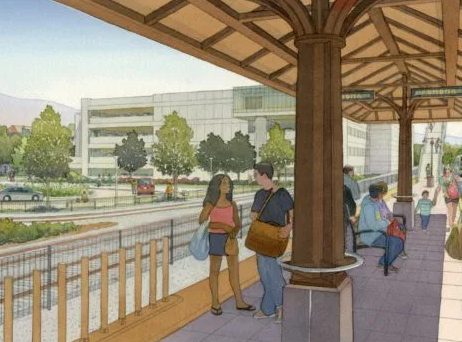The Metro Gold Line Extension Construction Authority hosted a public hearing Wednesday to gather feedback on its proposal to reduce planned parking by more than 1,600 spaces at future rail stations in Glendora, San Dimas, La Verne, Pomona and Claremont. To build more rail sooner, the Construction Authority is looking to reduce project construction costs, including the cost of building parking structures.
More than 180 people attended the hearing, the Construction Authority's first virtual public meeting. Twenty-four people submitted comments during the hearing. The slides from the public hearing are available at the Construction Authority website.
Though Metro plans to build the 12.3-mile Foothill Gold Line phase 2b extension all the way from Azusa to Montclair, current funding will only complete the line from Azusa to Pomona. The Construction Authority already awarded the contract for designing and building that section; it is expected to be completed by 2025. An additional $550 million is needed to build to Montclair; if the Construction Authority is able to get the money by next year, it expects to complete everything by 2028.
Early construction activities are already underway for the extension from Azusa to Pomona. Full-fledged construction is expected to start next month.
The current extension plan was approved in the Construction Authority's 2013 Final Environmental Impact Report. Reducing planned parking means revisiting that EIR. The Construction Authority is now doing a Supplemental Environmental Impact Report to study impacts of the project modifications - mainly reduced parking. The deadline to submit comments to be included in the SEIR is July 8.
The plan approved in the 2013 EIR called for building new parking structures at Glendora, San Dimas, La Verne, and Pomona Stations. The 2020 SEIR trims Glendora, San Dimas and La Verne parking capacity from 420, 450 and 600 spaces to 302, 289 and 299 spaces respectively.
The biggest decreases would be at Claremont and Pomona stations.
The new proposal changes the planned location for Pomona station parking, which would go from 1,000 spaces to 530. Instead of displacing an industrial site north of the station, the new proposal would instead be located south of the station, and would displace a handful of existing businesses and surface parking lots, and a couple of homes.
Claremont station parking would go from 1,100 spaces to 539. The Claremont station is the only location that has two proposed options. One includes adding a parking structure and another includes adding surface parking and leasing additional parking within a ¼-mile of the station.
In order to conform to Metro's parking demand forecast and its Supportive Transit Parking Program, the new proposal reduces station parking by constructing mostly surface lots. Surface lots are of course less expensive than structures, and can later be more easily converted into transit-oriented housing.
For La Verne station, the parking footprint would stay the same. There are no parking changes currently proposed for the Montclair Station, which already has 1,600 spaces.
But the new proposal would increase the footprint of parking lots at Glendora and San Dimas stations.
Construction Authority staff hopes to release a draft SEIR by August 2020 and will accept feedback on it for 45 days. Approval of the document is expected by November 2020.
In order to have comments be considered for review in the SEIR, they can be submitted in the following ways:
- Email: LLevyBuch@foothillgoldline.org
- Mail to: Lisa Levy Buch, Chief Communications Officer, Metro Gold Line Foothill Extension Construction Authority, 406 East Huntington Drive, Suite 202 Monrovia, CA 91016-3633
SGV Connect is supported by Foothill Transit, offering car-free travel throughout the San Gabriel Valley with connections to the new Gold Line Stations across the Foothills and Commuter Express lines traveling into the heart of downtown L.A. To plan your trip, visit Foothill Transit. “Foothill Transit. Going Good Places.”
Sign-up for our SGV Connect Newsletter, coming to your inbox every Friday starting on May 22:






